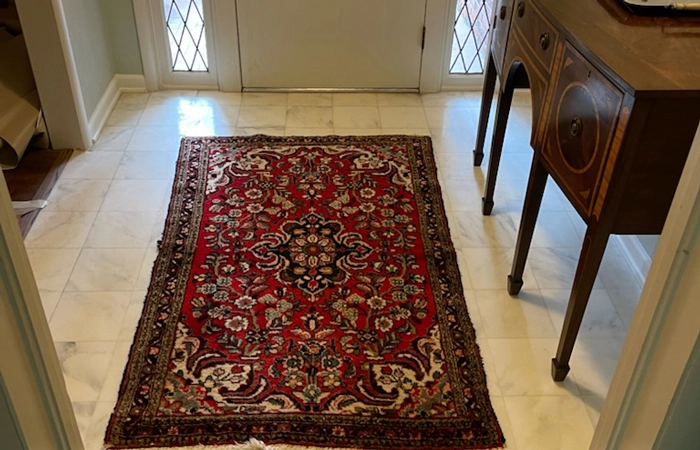When it comes to purchasing rugs, you might consider essential factors that vary from the rug’s origin to its colors and shape. But have you ever thought of how to keep rugs from sliding?
If you come up with this common way to use silicone caulking or hot glue on the bottom of rugs, you are deeply in a mistake.
Rugs with poor stability are not only unattractive but also potentially dangerous.
You need something better than a hot glue tutorial if you want to know how to prevent rugs from sliding around on the floor that cut through the noise.
Here are seven precious options available to follow to save you the trouble of replacing the floor coverings.
Rubber Waffle Rug Pads
The first way to keep rugs from sliding is using a high-quality non-slip rug pad.
Rug pads are available in a wide range of thicknesses and levels of durability, and they can be cut to suit rugs of varying shapes and sizes.
They act as a sound buffer and shock absorber to keep the rug in a particular place.
Check out the rug pads we offer below to find the one that will work best with your rug and flooring.
- Select a thin rubber rug pad (1/16″) for low-traffic areas ideal for a dining room where chairs will be dragged across the floor; these are a practical and stylish addition to any table.
- The All-In-One reversible rubber rug pad is the best choice if you have a rug, an uneven floor, tile, or any other hard surface.
Tip: The 1/8″ thickness makes it ideal for high-traffic areas and prevents rugs from bunching and sliding.
- A felt rug pad provides superior padding and security and is only for maximum safety. It works well on tile, stone, marble, wood, laminate, vinyl, and other uneven surfaces.
- It can be used over radiant heat floors and is reversible for rugs. It is common practice to apply a layer of natural rubber on the underside of felt rug pads in order to prevent them from slipping.
- The rubber outdoor rug pad is what you need for your rugs in the great outdoors. With this pad, your rug won’t slide around, and it won’t be a breeding ground for mildew and mold.
Where to buy Rubber Waffle Rug Pads
Tip: You may find rubber waffle rug pads in online shops, home goods, and home improvement sections of major retailers.
2. Rug Pins
Rug pins are helpful for securing the fringe of a rug when placed on top of a carpeted floor or hallway. The area rug is held in place by the carpet beneath it, and the pins are slanted so as not to go through both layers. The pin’s top is flat and transparent, making it less noticeable after it is in place.
3. Quick-Attachment Hooks and Loop-Type Fasteners
Similar to how Velcro fastens on children’s footwear, hook and loop anchors can do the same. An adhesive coating on the anchor’s underside can be used to secure it to the floor or the back of a rug. Next, the two sides of the rug are joined together to produce a connection that will keep it from moving.

4. Gripper Tape
Most gripper tape is 2 to 3 inches wide and comes on a roll. The tape is laid out directly on the floor in a grid or outline to accommodate the rug’s borders. It’s most effective on no bigger than 13 feet x 19.5 feet rugs. The rug and the gripper tape may be readily lifted off the floor and adjusted, making maintenance and cleaning a breeze.
5. Rug Tape
If your rug is constantly sliding around the room, Rug tape may be the answer. After being applied, the tape firmly secures the rug to the carpet.
Hardwood floors and rugs with an existing rubber backing are unsuitable.
Warning: Avoid using tape or anything else adhesive on hand-knotted or antique rugs because it might damage the rug by tearing at the fibers.
6. Double-Sided Rug Tape
You can get double-sided rug tape in either a roll or pre-cut squares. Different carpet tapes have different adhesive strengths and thicknesses. The most long-lasting tape is two-sided and features an acrylic adhesive, ideal for synthetic rugs like polypropylene.
Note: It’s important to read the carpet tape’s instructions before applying it to the floor to ensure you’re using the right kind of tape for the subfloor.
7. Rubber Stoppers
Thin, flat-weave rugs are a good match for the solid grid surfaces commonly used in producing natural rubber rug pads. They are more expensive than waffle rug pads, but good quality rubber has no chemicals that could damage your floors. Rubber pads prevent rugs from sliding on the floor but don’t offer much comfort.
Conclusion
In the end, these practical ways can keep rugs from sliding and relieve the concerns of rug damage since most people use hot glue or silicone caulking. It will be best to be careful about sticking things to the underside of your rug. When the hardened caulk or glue is walked on, it might leave a sticky residue on the floor.
